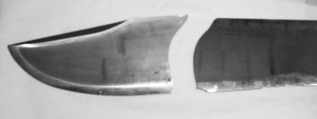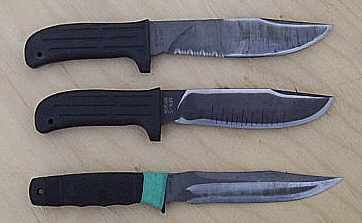
A shot of the Mission MPK in A2 from the Mission Knives website :

The review consists of :
This A2 MPK from Mission Knives was donated by Mission for a review.
The MPK-A2 is made by stock removal out of 1/4" thick A2 tool steel uniformly hardened to 57/58 HRC. The MPK-A2 has a seven inch blade with a full flat primary grind (3.5 +/- 0.3 degrees per side). The edge is 0.03" thick behind the bevel which is ground at 19-21 degrees per side. The knife weighs 360 g and is neutral in balance. The grip is made from Hytrel, a very durable material and fully encloses the tang. A MPK-A2 was reviewed previously.
Mission also makes a MPK in Beta-Titanium with the same geometry with the addition of two inches of serrations neat the base of the blade on the MPK-Ti. Both alloys can take a razor edge with ease and the knives have a similar edge geometry on the plain edge portion of the knives and the same tip profiles and handle, thus the performance will be identical in many respects. However The MPK-A2 differs from the MPK in Beta-Ti in several respects :
Because the MPK in A2 is much heavier than the MPK in Beta-Ti it is a much more efficient chopping tool. Comparing the two on various woods the MPK-A2 version would cut more than 50% as deep as the MPK-Ti. The harder edge was also not as prone to deformation. With both sharpened to a coarse edge (fine DMT rod), the MPK-A2 also had about twice the edge retention of the MPK-Ti. Details :
| # cuts | MPK-A2 | MPK-Ti | ||||
|---|---|---|---|---|---|---|
| Thread | Poly | Hemp | Thread | Poly | Hemp | |
| grams | cm | lbs | grams | cm | lbs | |
| 0 | 275 +/- 35 | 1.7 +/- 0.1 | N/A | 330 +/- 20 | 1.5 +/- 0.2 | N/A |
| 2 | 298 +/- 66 | 2.2 +/- 0.2 | 32 +/- 3 | 345 +/- 17 | 1.9 +/- 0.1 | 34 +/- 2 |
| 6 | 343 +/- 23 | 2.6 +/- 0.2 | 35 +/- 3 | 390 +/- 18 | 2.8 +/- 0.2 | 41 +/- 1 |
| 14 | 398 +/- 30 | 2.7 +/- 0.1 | 34 +/- 3 | 430 +/- 18 | 5.0 +/- 0.2 | 42 +/- 2 |
| 30 | 410 +/- 23 | 4.6 +/- 0.4 | 38 +/- 1 | N/A | ||
However the MPK-A2 would would rust far easier than the MPK-Ti, which is pretty much immune to such a concern. While the MPK-A2 is also much stiffer than the MPK-A2, when they are both leaned on heavily the MPK-A2 will crack under a lower strain because it isn't nearly as flexible. The MPK-A2 could not dig in the 2x4's as the MPK-Ti could, and lost a piece of the tip within a couple of attempts to pry a chip out. The MPK-A2 also broke while attempting to cut a tension bar in half, as it fractured due to the impacts from a hammer :

Another significant difference was revealed when the MPK's were both reprofiled with use of a slack belt sander. The edges on both blades were ground down to 10-11 degrees per side. While the MPK-A2 ground fine with no problems, the MPK-Ti took much longer to grind and would over heat quite rapidly and had to be cooled much more often than the MPK-A2. A shot of the new profiles (a SOG SEAL is included for reference, also reground) :

Both MPK's showed a large increase in cutting ability with the new profiles. Specifically for the MPK-A2 :
| Before | After | ||||
|---|---|---|---|---|---|
| edge angle | Hemp | Hardwood | edge angle | Hemp | Hardwood |
| degrees | pounds | slices | degrees | pounds | slices | 19-21 | 50 +/- 2 | 36 +/- 4 | 10-11 | 28 +/- 1 | 12 +/- 1 |
Note the huge difference in amount of force needed to push through through 3/8" hemp (rocking cut) and amount of slices needed to point a one inch basswood stake. The change in the wood whittling is larger due to the effect of fatigue playing a part in the performance. The rate of fatigue also gets reduced as edge profiles (and cutting ability in general) is enhanced. Of course with lower edge angles durability is always a concern, but the MPK-A2 had no problems with wood working and the like, however contacts off of hard materials such as rocks would be prone to inducing much more edge damage than with the initial edge angle of 19-21 degrees per side.
As noted previously with other knives, the lifetime of the cutting edge also increases when the edge angle is lowered. This was confirmed with the MPK-A2 which saw a huge increase in the slicing aggression with the new edge angle and a very aggressive finish. Left with an edge formed by a 100 grit AO belt, the MPK-A2 started off slicing the 3/8" hemp only requiring 16-18 lbs to make a cut, and after 254 cuts the force had only barely increased to 17-19 lbs. Though some wear was present under magnification, the edge finish was still very aggressive, and only needed a pound or two more force to make the cuts.
The MPK has an efficient cutting profile for a tactical style knife with a full flat grind and efficient edge thickness, and a slightly more acute angle than normal. The handle is made from Hytrel, a very durable material and has an ergonomic shape with a nice surface texture which combine to give a solid level of security. The MPK in A2 is a much better chopper than the MPK-Ti and has better edge retention on most materials, however or heavy prying, high impact work, or really corrosive environments, the MPK-Ti is a better choice.
Comments can be sent to : cliffstamp[REMOVE]@cutleryscience.com or by posted to :
| Last updated : | 01 : 10 : 2006 |
| Originally written: | Thu Jun 12 14:58:50 NDT 2003 |